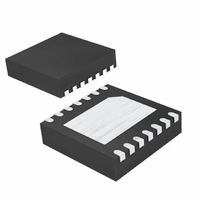MAX8792ETD+T Maxim Integrated Products, MAX8792ETD+T Datasheet - Page 15

MAX8792ETD+T
Manufacturer Part Number
MAX8792ETD+T
Description
IC PWM CONTROLLER 14TDFN
Manufacturer
Maxim Integrated Products
Datasheet
1.MAX8792ETDT.pdf
(29 pages)
Specifications of MAX8792ETD+T
Applications
PWM Controller
Voltage - Input
2 ~ 26 V
Current - Supply
700µA
Operating Temperature
-40°C ~ 80°C
Mounting Type
Surface Mount
Package / Case
14-TDFN Exposed Pad
Lead Free Status / RoHS Status
Lead free / RoHS Compliant
Voltage - Supply
-
Lead Free Status / Rohs Status
Lead free / RoHS Compliant
Slowly discharging the output capacitors by slewing
the output over a long period of time (typically 0.5ms to
2ms) keeps the average negative inductor current low
(damped response), thereby preventing the negative
output-voltage excursion that occurs when the con-
troller discharges the output quickly by permanently
turning on the low-side MOSFET (underdamped
response). This eliminates the need for the Schottky
diode normally connected between the output and
ground to clamp the negative output-voltage excursion.
After the controller reaches the zero target, the
MAX8792 shuts down completely—the drivers are dis-
abled (DL and DH pulled low)—the reference turns off,
and the supply currents drop to about 0.1µA (typ).
When a fault condition—output UVP or thermal shut-
down—activates the shutdown sequence, the protection
circuitry sets the fault latch to prevent the controller from
restarting. To clear the fault latch and reactivate the
controller, toggle EN or cycle V
The MAX8792 automatically uses pulse-skipping mode
during soft-start and uses forced-PWM mode during
soft-shutdown, regardless of the SKIP configuration.
The low-noise, forced-PWM mode (SKIP = V
ables the zero-crossing comparator, which controls the
low-side switch on-time. This forces the low-side gate-
drive waveform to constantly be the complement of the
high-side gate-drive waveform, so the inductor current
reverses at light loads while DH maintains a duty factor
of V
keep the switching frequency fairly constant. However,
forced-PWM operation comes at a cost: the no-load 5V
bias current remains between 10mA to 50mA, depend-
ing on the switching frequency.
The MAX8792 automatically always uses forced-PWM
operation during shutdown, regardless of the SKIP
configuration.
In skip mode (SKIP = GND or 3.3V), an inherent auto-
matic switchover to PFM takes place at light loads. This
switchover is affected by a comparator that truncates
the low-side switch on-time at the inductor current’s
zero crossing. The zero-crossing comparator threshold
is set by the differential across LX to GND.
DC output-accuracy specifications refer to the thresh-
old of the error comparator. When the inductor is in
continuous conduction, the MAX8792 regulates the val-
ley of the output ripple, so the actual DC output voltage
OUT
/V
IN
. The benefit of forced-PWM mode is to
______________________________________________________________________________________
Forced-PWM Mode ( S S K K I I P P = V
Automatic Pulse-Skipping Mode
Modes of Operation
CC
( S S K K I I P P = GND or 3.3V)
power below 0.5V.
Controller with Dynamic REFIN
Single Quick-PWM Step-Down
DD
) dis-
DD
)
is higher than the trip level by 50% of the output ripple
voltage. In discontinuous conduction (SKIP = GND and
I
lation level higher than the error-comparator threshold
by approximately 1.5% due to slope compensation.
When SKIP is pulled to GND, the MAX8792 remains in
pulse-skipping mode. Since the output is not able to
sink current, the timing for negative dynamic output-volt-
age transitions depends on the load current and output
capacitance. Letting the output voltage drift down is typ-
ically recommended in order to reduce the potential for
audible noise since this eliminates the input current
surge during negative output-voltage transitions.
Leaving SKIP unconnected activates a unique pulse-
skipping mode with a minimum switching frequency of
18kHz. This ultrasonic pulse-skipping mode eliminates
audio-frequency modulation that would otherwise be
present when a lightly loaded controller automatically
skips pulses. In ultrasonic mode, the controller automati-
cally transitions to fixed-frequency PWM operation when
the load reaches the same critical conduction point
(I
An ultrasonic pulse occurs when the controller detects
that no switching has occurred within the last 33µs.
Once triggered, the ultrasonic controller pulls DL high,
turning on the low-side MOSFET to induce a negative
inductor current (Figure 3). After the inductor current
reaches the negative ultrasonic current threshold, the
controller turns off the low-side MOSFET (DL pulled low)
Figure 3. Ultrasonic Waveform
OUT
LOAD(SKIP)
< I
LOAD(SKIP)
0
) that occurs when normally pulse skipping.
I
SONIC
Ultrasonic Mode ( S S K K I I P P = Open = 3.3V)
33μs (typ)
), the output voltage has a DC regu-
ZERO-CROSSING
ON-TIME (t
DETECTION
ON
)
INDUCTOR
CURRENT
15











